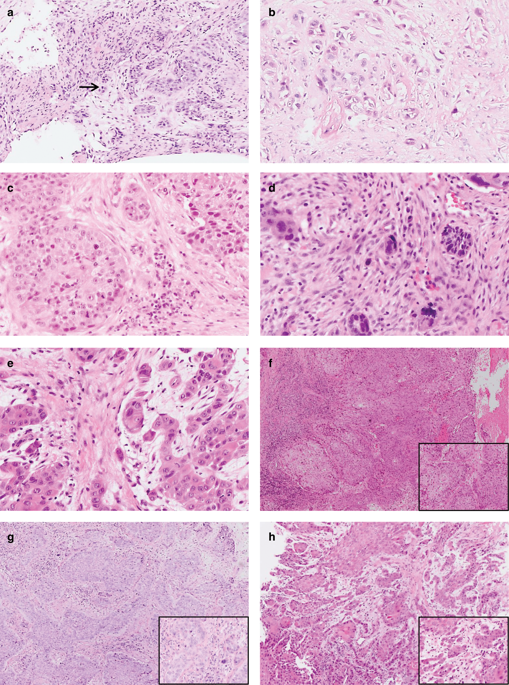当前位置:
X-MOL 学术
›
Br. J. Cancer
›
论文详情
Our official English website, www.x-mol.net, welcomes your
feedback! (Note: you will need to create a separate account there.)
Pre-operative cellular dissociation grading in biopsies is highly predictive of post-operative tumour stage and patient outcome in head and neck squamous cell carcinoma.
British Journal of Cancer ( IF 6.4 ) Pub Date : 2020-01-15 , DOI: 10.1038/s41416-019-0719-8 Moritz Jesinghaus 1, 2 , Katja Steiger 1 , Fabian Stögbauer 1 , Bernhard Haller 3 , Andreas Kolk 4 , Ulrich Straßen 5 , Anja Pickhard 5 , Markus Wirth 5 , Miguel Silva 2 , Jan Budczies 6 , Aaron Becker von Rose 7 , Björn Konukiewitz 1 , Peer Kuhn 1 , Konrad Klinghammer 8 , Hendrik Dapper 9 , Stefan Münch 9 , Stephanie E Combs 9, 10, 11 , Wilko Weichert 1, 10 , Melanie Boxberg 1
British Journal of Cancer ( IF 6.4 ) Pub Date : 2020-01-15 , DOI: 10.1038/s41416-019-0719-8 Moritz Jesinghaus 1, 2 , Katja Steiger 1 , Fabian Stögbauer 1 , Bernhard Haller 3 , Andreas Kolk 4 , Ulrich Straßen 5 , Anja Pickhard 5 , Markus Wirth 5 , Miguel Silva 2 , Jan Budczies 6 , Aaron Becker von Rose 7 , Björn Konukiewitz 1 , Peer Kuhn 1 , Konrad Klinghammer 8 , Hendrik Dapper 9 , Stefan Münch 9 , Stephanie E Combs 9, 10, 11 , Wilko Weichert 1, 10 , Melanie Boxberg 1
Affiliation

|
BACKGROUND
Pre-operative treatment planning in head and neck squamous cell carcinoma (HNSCC) is mainly dictated by clinical staging, which has major shortcomings. Histologic grading is irrelevant due to its lack of prognostic impact. Recently, a novel grading termed Cellular Dissociation Grade (CDG) based on Tumour Budding and Cell Nest Size was shown to be highly prognostic for resected HNSCC. We aimed to probe the predictive and prognostic impact of CDG in the pre-operative biopsies of HNSCC.
METHODS
We evaluated CDG in n = 160 pre-therapeutic biopsies from patients who received standardised treatment following German guidelines, and correlated the results with pre- and post-therapeutic staging data and clinical outcome.
RESULTS
Pre-operative CDG was highly predictive of post-operative tumour stage, including the prediction of occult lymph node metastasis. Uni- and multivariate analysis revealed CDG to be an independent prognosticator of overall, disease-specific and disease-free survival (p < 0.001). Hazard ratio for disease-specific survival was 6.1 (11.1) for nG2 (nG3) compared with nG1 tumours.
CONCLUSIONS
CDG is a strong outcome predictor in the pre-treatment scenario of HNSCC and identifies patients with nodal-negative disease. CDG is a purely histology-based prognosticator in the pre-therapeutic setting that supplements clinical staging and may aide therapeutic stratification of HNSCC patients.
中文翻译:

活检术前细胞解离分级可高度预测头颈部鳞状细胞癌的术后肿瘤分期和患者预后。
背景技术头颈部鳞状细胞癌(HNSCC)的术前治疗计划主要由临床分期决定,这有很大的缺点。由于缺乏预后影响,组织学分级无关紧要。最近,一种基于肿瘤出芽和细胞巢大小的称为细胞解离等级 (CDG) 的新分级被证明对切除的 HNSCC 具有高度预后意义。我们的目的是探讨 CDG 在 HNSCC 术前活检中的预测和预后影响。方法 我们根据德国指南对接受标准化治疗的患者进行的 n = 160 例治疗前活组织检查评估了 CDG,并将结果与治疗前后的分期数据和临床结果相关联。结果 术前 CDG 高度预测术后肿瘤分期,包括隐匿性淋巴结转移的预测。单变量和多变量分析显示 CDG 是总体、疾病特异性和无病生存的独立预后因子 (p < 0.001)。与 nG1 肿瘤相比,nG2 (nG3) 的疾病特异性生存风险比为 6.1 (11.1)。结论 CDG 是 HNSCC 治疗前情景中的一个强有力的结果预测因子,可识别淋巴结阴性疾病患者。CDG 是治疗前环境中纯粹基于组织学的预后指标,可补充临床分期,并可能有助于 HNSCC 患者的治疗分层。1) 与 nG1 肿瘤相比,nG2 (nG3)。结论 CDG 是 HNSCC 治疗前情景中的一个强有力的结果预测因子,可识别淋巴结阴性疾病患者。CDG 是治疗前环境中纯粹基于组织学的预后指标,可补充临床分期,并可能有助于 HNSCC 患者的治疗分层。1) 与 nG1 肿瘤相比,nG2 (nG3)。结论 CDG 是 HNSCC 治疗前情景中的一个强有力的结果预测因子,可识别淋巴结阴性疾病患者。CDG 是治疗前环境中纯粹基于组织学的预后指标,可补充临床分期,并可能有助于 HNSCC 患者的治疗分层。
更新日期:2020-01-15
中文翻译:

活检术前细胞解离分级可高度预测头颈部鳞状细胞癌的术后肿瘤分期和患者预后。
背景技术头颈部鳞状细胞癌(HNSCC)的术前治疗计划主要由临床分期决定,这有很大的缺点。由于缺乏预后影响,组织学分级无关紧要。最近,一种基于肿瘤出芽和细胞巢大小的称为细胞解离等级 (CDG) 的新分级被证明对切除的 HNSCC 具有高度预后意义。我们的目的是探讨 CDG 在 HNSCC 术前活检中的预测和预后影响。方法 我们根据德国指南对接受标准化治疗的患者进行的 n = 160 例治疗前活组织检查评估了 CDG,并将结果与治疗前后的分期数据和临床结果相关联。结果 术前 CDG 高度预测术后肿瘤分期,包括隐匿性淋巴结转移的预测。单变量和多变量分析显示 CDG 是总体、疾病特异性和无病生存的独立预后因子 (p < 0.001)。与 nG1 肿瘤相比,nG2 (nG3) 的疾病特异性生存风险比为 6.1 (11.1)。结论 CDG 是 HNSCC 治疗前情景中的一个强有力的结果预测因子,可识别淋巴结阴性疾病患者。CDG 是治疗前环境中纯粹基于组织学的预后指标,可补充临床分期,并可能有助于 HNSCC 患者的治疗分层。1) 与 nG1 肿瘤相比,nG2 (nG3)。结论 CDG 是 HNSCC 治疗前情景中的一个强有力的结果预测因子,可识别淋巴结阴性疾病患者。CDG 是治疗前环境中纯粹基于组织学的预后指标,可补充临床分期,并可能有助于 HNSCC 患者的治疗分层。1) 与 nG1 肿瘤相比,nG2 (nG3)。结论 CDG 是 HNSCC 治疗前情景中的一个强有力的结果预测因子,可识别淋巴结阴性疾病患者。CDG 是治疗前环境中纯粹基于组织学的预后指标,可补充临床分期,并可能有助于 HNSCC 患者的治疗分层。











































 京公网安备 11010802027423号
京公网安备 11010802027423号